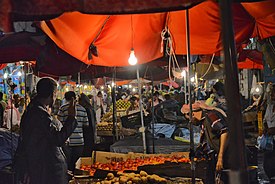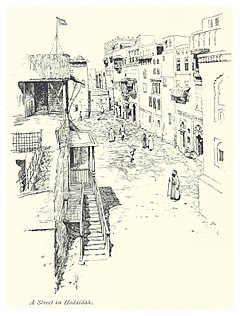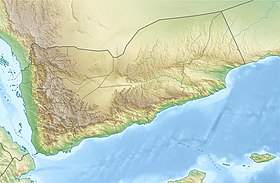Al Hudaydah
al-Hudaydah
الْحُدَيْدَة | |
|---|---|
 Market in Al-Hudaydah | |
| Coordinates: 14°48′08″N 42°57′04″E / 14.80222°N 42.95111°E | |
| Country | |
| Governorate | Al Hudaydah |
| Administration | United Nations (de jure)[1] |
| Elevation | 17 m (56 ft) |
| Population (2004)[2] | |
• Total | 404,062 |
• Estimate (2023)[2] | 734,699 |
| Time zone | UTC+3 (Yemen Standard Time) |
Al Hudaydah (Arabic: الْحُدَيْدَة, romanized: al-ḥudayda), also transliterated as Hodeda, Hodeida, Hudaida or Hodeidah, is the fourth-largest city in Yemen and its principal port on the Red Sea and it is the centre of Al Hudaydah Governorate. As of 2023, it has an estimated population of 735,000.[2]
History
[edit]In Islamic chronicles, the name Al-Hudaydah was first mentioned in the year 1454/55. The city's importance grew in the 1520s, when the Ottomans took over the Yemeni Tihāmah region.[3]
In the 1830s, Al-Hudaydah was controlled by Ibrahim Pasha's troops, which turned over its administration to Sherif Husayn ibn Ali Haydar.[4] In 1849, it became part of the Yemen Eyalet.
The Malay writer Abdullah bin Abdul Kadir visited Al-Hudaydah on his pilgrimage to Mecca in 1854, and describes the city in his account of the journey, mentioning that the custom of chewing khat was prevalent in the city at this time.[5]
During the 19th century, Al-Hudaydah had a large slave market. The slaves came from the Oromia region of modern Ethiopia.[6]

In 1914, during World War I, Imperial German troops led by Major Freiherr Othmar von Stotzingen established "Stotzingen-Mission", a wireless station, at Al-Hudaydah, which was used during the Arab Revolt to relay communications from Constantinople (now Istanbul) to German East Africa as well as broadcast propaganda to Anglo-Egyptian Sudan, Somalis land part of population Northern side and Abyssinia.[7]
The city was briefly occupied by Saudi forces during the Saudi–Yemeni war of 1934.[8][9]
After a disastrous fire in January 1961 destroyed much of Al-Hudaydah, it was rebuilt, particularly the port facilities, with Soviet aid. A highway to Sanaa, the capital, was completed in 1961. The city was also the site of a Soviet naval base in the 1970s and 1980s.
On 20 July 2024, during the Israel–Hamas war, the city was the target of an Israeli air raid in response to repeated Houthi attacks against Israel and an attack on Tel Aviv that resulted in the death of a civilian. The Israeli strike targeted port oil facilities and a power plant, resulting in a large fire killing six and wounding 87. The IDF said that they targeted military facilities.[10]
Economy
[edit]Situated on the Red Sea, Al-Hudaydah is an important port, exporting coffee, cotton, dates and hides. It was developed as a seaport in the mid-19th century by the Ottoman Turks. As of June 2018, three quarters of humanitarian and commercial cargo entering Yemen arrived via the port of Hudaydah.[11] It serves as the entry point for Yemen's humanitarian aid and around 70% of commercial imports.[12] The port of Ras Isa is slightly north of Al Hudaydah proper, and is the terminus of the Marib–Ras Isa oil pipeline from inland Yemen, with a major storage and offloading vessel named FSO Safer moored offshore, though idled since the beginning of the Yemeni Civil War in 2015.[13][14]
In 1920, the British described Al Hudaydah's port as being a "poor harbour." With two entrances, it was only able to provide adequate storage and shelter for small boats, with larger boats and ships having to dock over two miles away. In 1908, a new pier was built, which had trouble with depth, leading most imported items to be dumped on the beach instead of delivered by dock. Coal was often available for visiting vessels. A new harbour was built 10 miles northwest of the town by the Ottoman government, with a small train line leading to Al Hudaydah, and connected to the Sana-Hodeida Railway. A French company built the rail system, which was halted upon the Italo-Turkish War breakout. In 1909, the port was bringing in less than the port at Jeddah. That year, 172 steam ships visited the port. The majority of the goods were from the United Kingdom, followed by Italy, Russia and Germany. German imports had grown from 1905 to 1909, with British shipping declining.[15] Despite struggles with a good quality harbour, the town was described as being the centre of dhow building.[16]
The city was known for producing striped coarse cotton cloth, woven by hand. The artisans making the cloth were relocated to Al Hudaydah from Zabīd and Beit el-Faki due to tribal conflict.[16] The city was also a centre for tanning and sandal making.[16]
In the late 19th century, Al-Hudaydah was a major exporter of coffee, although its export business shifted to Aden in the early 20th century due to more secure routes there. Al-Hudaydah had to transport its goods through Yemen and Indian ports for security reasons, making export to the United Kingdom troublesome. During this time period, the region imported cereal and rice from India, cotton from Manchester, England and the United States, iron and steel from Germany, and general goods from Italy and Austria. As of 1920, the city was exporting fuller's earth, hides, and coffee.[15] The coffee produced in Al-Hudaydah was considered some of the finest in the region.[17]
Yemeni civil war
[edit]The Hudaydah Port plays a crucial role in allowing food to be imported into the country. This role has been disrupted several times over the course of the Yemeni civil war.
In June 2018, pro-Hadi government forces with the backing of the United Arab Emirates and Saudi Arabia entered the port, in an effort to dislodge Houthi forces.[11][18] Due to the risk of a humanitarian crisis if the port is besieged, the United Nations attempted to secure an agreement with the Houthis to place the port under UN control, but was unsuccessful until 13 December 2018, on which date there was an announcement by UN Secretary-General António Guterres that the two sides to the civil war have reached an agreement on a ceasefire.[11][19] In July 2024, the port was attacked by Israel in retaliation for the Houthi drone strike on Tel Aviv.[20]
Topography
[edit]Al-Hudaydah is generally composed of a flat plain that gently slopes towards the sea. The elevated areas consist mainly of small sand dunes or remnants of inland masses. Geologically, this coastal plain is part of the Red Sea rift valley, covered by recent deposits, which can be divided into two categories, though it’s difficult to distinguish their boundaries. Near the Red Sea coast, the deposits are primarily marine formations from the late Tertiary and Quaternary periods, covered by modern wind-blown sand deposits. In contrast, near the foothills of the mountains, deltaic deposits are found, some of which are coarse, consisting of large gravel and rock fragments, while others are finer particles carried by streams descending from the mountains. These coarse deltaic deposits gradually disappear under sand deposits, and at the boundary between the two, freshwater springs emerge.
The province's surface can be divided into three sections:
Coastal Plains: The majority of Al-Hudaydah’s land lies within the Tihama coastal plain, which stretches from Al-Luhayyah in the north to Al-Khawkhah in the south, spanning approximately 300 kilometers in length and 60 to 150 kilometers in width. This plain is traversed by several valleys, which are outlets for flood and rainwater flowing from the internal highlands of the province and from the highlands and mountains of the neighboring provinces of Ibb, Dhamar, Sana'a, Al-Mahwit, and Hajjah, eventually emptying into the Red Sea. Major valleys include, Wadi Mour, Wadi Siham, Wadi Zabid, among others.
Mountain Highlands: Notable mountains include Jabal Ras and Jabal Bura, both reaching elevations of 2,000 to 2,400 meters above sea level.
Islands: There are over 40 Yemeni islands in the Red Sea off the coast of Al-Hudaydah, with notable ones being Kamaran,Hanish Islands, and Taqfash Island.[21]
Climate
[edit]Al Hudaydah has a hot desert climate (Köppen climate classification: BWh).
| Climate data for Al Hudaydah | |||||||||||||
|---|---|---|---|---|---|---|---|---|---|---|---|---|---|
| Month | Jan | Feb | Mar | Apr | May | Jun | Jul | Aug | Sep | Oct | Nov | Dec | Year |
| Mean daily maximum °C (°F) | 28.8 (83.8) |
29.2 (84.6) |
30.4 (86.7) |
32.6 (90.7) |
34.3 (93.7) |
35.9 (96.6) |
36.7 (98.1) |
36.4 (97.5) |
35.7 (96.3) |
35.7 (96.3) |
31.4 (88.5) |
29.1 (84.4) |
33.0 (91.4) |
| Daily mean °C (°F) | 25.1 (77.2) |
25.9 (78.6) |
27.7 (81.9) |
29.5 (85.1) |
31.3 (88.3) |
32.6 (90.7) |
33.0 (91.4) |
32.6 (90.7) |
32.0 (89.6) |
30.3 (86.5) |
27.2 (81.0) |
25.5 (77.9) |
29.4 (84.9) |
| Mean daily minimum °C (°F) | 20.3 (68.5) |
21.7 (71.1) |
23.1 (73.6) |
25.6 (78.1) |
26.7 (80.1) |
28.3 (82.9) |
28.4 (83.1) |
28.2 (82.8) |
27.2 (81.0) |
25.0 (77.0) |
22.6 (72.7) |
20.0 (68.0) |
24.8 (76.6) |
| Average rainfall mm (inches) | 18 (0.7) |
15 (0.6) |
12 (0.5) |
33 (1.3) |
3 (0.1) |
0 (0) |
5 (0.2) |
12 (0.5) |
4 (0.2) |
3 (0.1) |
0 (0) |
2 (0.1) |
107 (4.2) |
| Average relative humidity (%) | 81 | 81 | 82 | 82 | 79 | 76 | 75 | 76 | 72 | 76 | 78 | 82 | 78 |
| Mean daily sunshine hours | 8.6 | 8.5 | 8.3 | 9.0 | 9.4 | 7.4 | 6.7 | 7.2 | 7.6 | 9.5 | 9.8 | 8.9 | 8.4 |
| Source: Arab Meteorology Book[22] | |||||||||||||
See also
[edit]References
[edit]- ^ "Parties to Conflict in Yemen Have Accepted Plan for Redeployment of Forces from Hodeidah Port, Special Envoy Tells Security Council | Meetings Coverage and Press Releases". www.un.org. Retrieved 1 January 2024.
- ^ a b c "Al-Hudaydah Population 2023". worldpopulationreview.com. Retrieved 1 January 2024.
- ^ "Al-Ḥudaydah". britannica. Retrieved July 23, 2018.
- ^ Caesar E. Farah. "Anglo-Ottoman confrontation in Yemen: 1840-49". dergipark.org. p. 74.
- ^ Ché-Ross, Raimy (July 2000). "Munshi Abdullah's Vogage to Mecca: A Preliminary Introduction and Annotated Translation". Indonesia & the Malay World. 28 (81): 196.
- ^ Waldmeier, Theophilus (1886). "The autobiography of Theophilus Waldmeier, missionary: being an account of ten years' life in Abyssinia; and sixteen years in Syria". London : S.W. Partridge. p. 34. Retrieved 1 January 2024.
- ^ Waugh, Sir Telford (1937). Royal Central Asian Journal Volume XXIV part II. p. 313.translating the German account given in the German journal, Orient Rundschau
- ^ David Bidwell (2012). Dictionary Of Modern Arab History. Routledge. p. 294. ISBN 9781136162916.
- ^ Massimiliano Fiore (2016). Anglo-Italian Relations in the Middle East, 1922–1940. Routledge. pp. 32–3. ISBN 9781317180944.
- ^ "Israel says it struck Yemen's Hodeidah in response to Houthi attacks". Al Jazeera. Retrieved 2024-07-20.
- ^ a b c Nissenbam, Dion. "U.S. Deepens Role in Yemen Fight, Offers Gulf Allies Airstrike-Target Assistance". The Wall Street Journal. Archived from the original on June 13, 2018. Retrieved June 13, 2018.
- ^ Hasson, Nir; Khoury, Jack (2018-11-07). "Israeli Panel Approves 640 New Settler Homes in East Jerusalem". Haaretz. Retrieved 2018-11-08.
- ^ "Report: Houthis Seeking Help to Prevent Massive Oil Spill off Yemen from Leaking FSO". World Maritime News. 17 December 2019. Retrieved 19 December 2019.
- ^ "Experts fear deserted oil tanker off Yemen could explode". The Guardian. 23 July 2019. Retrieved 19 December 2019.
- ^ a b Prothero, G.W. (1920). Arabia. London: H.M. Stationery Office. p. 70.
- ^ a b c Prothero, G.W. (1920). Arabia. London: H.M. Stationery Office. p. 99.
- ^ Prothero, G.W. (1920). Arabia. London: H.M. Stationery Office. p. 83.
- ^ Nissenbaum, Dion; Stancati, Margherita (13 June 2018). "Yemeni Forces, Backed by Saudi-Led Coalition, Launch Assault on Country's Main Port". The Wall Street Journal. Archived from the original on 13 June 2018. Retrieved 20 June 2018.
- ^ "Truce breakthrough in Yemen talks". BBC News. December 13, 2018.
- ^ "Houthi TV says Israeli airstrikes target Yemen's Hodeidah port". Reuters. July 20, 2024.
- ^ https://yemen-nic.info/gover/hodiada/brife/
- ^ "Appendix I: Meteorological Data" (PDF). Springer. Archived from the original (PDF) on March 4, 2016. Retrieved 14 October 2024.

